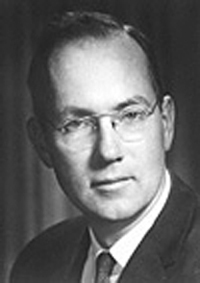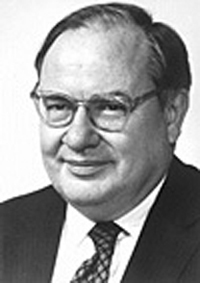December 1958: Invention of the Laser
   Charles Townes  Arthur Schawlow |
Every now and then, a scientific breakthrough occurs that has a revolutionary impact on daily life. One example of this is the invention of the laser, which stands for light amplification by stimulated emission of radiation. Few people realized at the time of its invention that it would prove to be such a useful (and lucrative) device, but the laser ultimately launched a new scientific field and opened the door to what is today a multi-billion dollar industry.
The principle of the laser dates back to 1917, when Albert Einstein first described the theory of stimulated emission, but the practical device has its roots in the 1940s and early 1950s, particularly the work on microwave spectroscopy-a powerful tool for discovering thecharacteristics of a wide variety of molecules-by physicists Charles Townes, Arthur Schawlow and others, and the subsequent invention of the maser (microwave amplification by stimulated emission of radiation).
After World War II had ended, Townes was intrigued by the possibility of using stimulated emission to probe gases for molecular spectroscopy. As the wavelength of the microwave radiation grew shorter, its interactions with molecules became stronger, making it a more powerful spectroscopic tool. Townes and colleagues at Columbia University demonstrated a working maser in 1953, two years after similar devices were independently invented by researchers at the University of Maryland and Lebedev Laboratories in Moscow.
However, Townes realized that the wavelengths of infrared and optical light, because they were shorter, would be even more powerful tools for spectroscopy, and mentioned the idea of extending the maser principle to shorter wavelengths to Schawlow while visiting the latter at Bell Labs. Schawlow came up with the idea of arranging a set of mirrors, one on each end of the device's cavity, to bounce the light back and forth, thus eliminating the amplification of any beams bouncing in other directions. He thought that this would enable them to adjust the dimensions so that the laser would only have one frequency which could be selected within a given line width, and that the mirror size could be adjusted so that even slight off axis motion could be damped. He also suggested using certain solid state materials for the lasers.
Eight months later, the two men wrote a paper on the proof of concept for their work, published in the December 1958 issue of the Physical Review (Vol. 112, No. 6, pp. 1940-1949), and received a patent for the invention of the laser two years later-the same year the first working laser was built by Theodore Maiman at Hughes Aircraft Company. Townes was a co-recipient of the 1964 Nobel Prize in Physics for his fundamental work in quantum electronics that provided the basis of the maser/laser principle. Schawlow's recognition came much later; he shared the 1981 Nobel Prize for his contributions to the development of laser spectroscopy.
While Townes and Schawlow are the names most often associated with the invention of the laser because of their 1958 paper and subsequent patent, numerous others made vital contributions. Perhaps that is why the question of who really invented the laser has proven to be a fairly litigious one, due in large part to the efforts of Gordon Gould, a scientist at Columbia and later with Technical Research Group (TRG), to earn patent rights based on his research notebook. An entry on his initial ideas for the laser was dated and notarized November 1957. Gould fought for decades, and in 1973 the US Court of Customs and Patent Appeals ruled that the original patent awarded to Schawlow and Townes was too general, and did not supply enough information to create certain key components. Gould was finally granted patent rights, receiving his fourth and final patent on lasers in 1988.
Although it was a remarkable technical breakthrough, in its early years the laser did not have many practical applications, since it was not powerful enough for use in beam-based weaponry, and its ability to transmit information through the atmosphere was severely hampered by its inability to penetrate clouds and rain. But it didn't take long for researchers to develop the first laser sighting systems and the first tools for laser surgery.
Today, lasers are ubiquitous in the commercial marketplace, used in CD players, in corrective eye surgery, tattoo removal, industrial assembly lines, supermarket scanners, optical communications, and optical data storage.
Further Reading:
Bromberg, Joan L., "The Birth of the Laser", Physics Today, October 1988, pp. 26-33.
"A Laser Patent That Upsets the Industry," Business Week, 24 October 1977, pp. 121-130.
Hecht, Jeff, "Winning the Laser Patent War," Laser Focus World, December 1994, pp. 49-51.
©1995 - 2024, AMERICAN PHYSICAL SOCIETY
APS encourages the redistribution of the materials included in this newspaper provided that attribution to the source is noted and the materials are not truncated or changed.
Associate Editor: Jennifer Ouellette
December 2003 (Volume 12, Number 11)
Articles in this Issue

